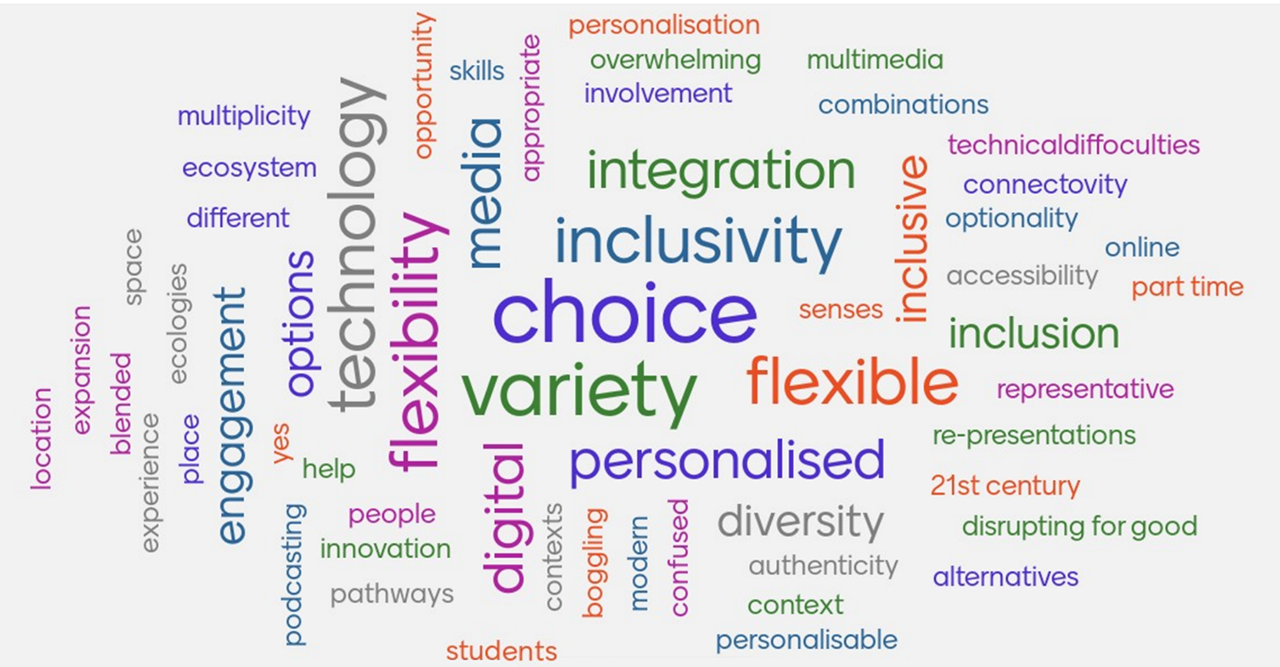10 July 2023
How are we using different modes of communication to engage students with their learning?

Author
Professor Sam Elkington
Teesside University
As our approaches to learning and teaching continue to evolve, we can reflect on how we work together to develop our understanding and communication of information. Moreover, it is now more important than ever that we consider how we work collaboratively, as educators and students, on the construction and communication of knowledge and meaning, and the role that technology can play in this.
Initial work completed as part of our QAA Collaborative Enhancement Project has focused on what ‘multimodality’ means in the context of higher education learning, teaching and assessment. We recognise the input of Bouchey et al (2021, p36), by considering multimodality as looking ‘at the many different modes that people use to communicate with each other and to express themselves. Multimodal learning is relevant as increases in technological tools and associated access to multimedia composing software have led to the ease of use of many modes in presenting, representing, and responding to information’.
The post-pandemic higher education context, with its nuances and complexity, provides this project with a rare opportunity to consider the ‘new normalities’ we have all glimpsed as we deal with the challenges of engaging our students in and across the physical, digital, and connected environments. As a project team we are acutely aware of this emergent multidimensionality of practice and are keen to acknowledge and reflect it in our own methods of inquiry. Harnessing multimodalities seems to be about valuing and accommodating diversity, not only in adverse conditions, but in terms of the range of digital and physical tools and spaces that we can use to engage students in the wider learning environment.
As experienced academic practitioners, developers and researchers, we have understood that multimodality is about recognising new and alternative ways of learning and teaching by developing alternative, flexible and adaptive learning environments. Our project team members therefore have specific interests linked to multimodality, as well as investment in the collective project. Specific areas of interest include how:
- visual-spatial ability can empower students and teachers
- the digital transformation of physical and virtual educational environments can facilitate the development of knowledge in new and engaging ways
- generative artificial intelligence can be effectively integrated into teaching, learning and assessment that enhances the student learning experience and student success.
The project also aims to explore creative approaches to, and the benefits from, utilising immersive education, where technology is integrated with more traditional approaches to higher education.
We began our project work by defining our terms and co-creating a glossary. We also presented, and engaged with peers from the sector, at QAA’s annual Quality Insights Conference (23 February 2023), introducing our initial definitions. In this collaborative session, we received confirmation from participants (approximately 35) that our divergent mapping of multimodalities was a useful starting point for our broader project. We captured responses through several activities in the QAA workshop and created a word cloud using Mentimeter which was generated by participants responding to our initial prompt question “What does multimodality mean to you?”

Analysis of the feedback from the activities at the QAA workshop has led to the development of a model composed of four intersecting themes that we feel should inform a contemporary view of multimodality in higher education:
- Experience
- Philosophy
- Innovation
- Practice
We have learnt from peers that multimodality means more than the technical modes and platforms we use. In designing multimodal spaces for learning, we need to hold in mind our beliefs about education and what we want it to be, the educational experiences that we have and want to have, an innovator's mindset that seeks to always enhance the spaces we use, as well as the practices associated with teaching, learning, assessment, and supporting the student experience. These themes will frame the next steps in the project, with the aim of further engaging stakeholders in what multimodality in higher education is, and how it can be articulated and embedded within learning and teaching.
In undertaking our work so far, our project team has been intentionally multimodal. We have met online and in person, used combinations of synchronous and asynchronous forms of interaction and collaboration, and benefited from available technologies. We invite you, the reader, to do the same and join us in considering what multimodality might mean for your practice in higher education. We welcome your engagement with our project and planned outputs, starting with this blog post and our future podcasts.
You can read more about this project, and access resources once completed, on the QAA website: Harnessing multimodality in higher education principles for new learning teaching and assessment.
With thanks to Paul Chesterton (Teesside University), Ann Thanaraj (Teesside University), Andrew Middleton (Anglia Ruskin University), Birgit Fraser (Anglia Ruskin University), Maggie Gibson (Birmingham City University), Rachel Curzon (Birmingham City University), Emma Kennedy (University of Greenwich) and Jimmy Lo (University of Greenwich) for their contributions to this blog.
